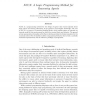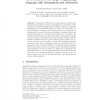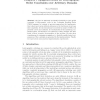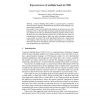TPLP
2010
14 years 5 months ago
2010
Constraint Handling Rules (CHR) is a high-level programming language based on multiheaded multiset rewrite rules. Originally designed for writing user-defined constraint solvers,...
CORR
2004
Springer
14 years 7 months ago
2004
Springer
FLUX is a programming method for the design of agents that reason logically about their actions and sensor information in the presence of incomplete knowledge. The core of FLUX is...
COLING
2000
14 years 8 months ago
2000
In this paper, lmrsing-as-deduction and constraint programming are brought together to outline a procedure for the speeitication of constraint-based chart parsers. Fob lowing the ...
ICLP
2005
Springer
15 years 20 days ago
2005
Springer
We present HYPROLOG, a novel integration of Prolog with assumptions and abduction which is implemented in and partly borrows syntax from Constraint Handling Rules (CHR) for integri...
CSCLP
2005
Springer
15 years 21 days ago
2005
Springer
We give an efficiently executable specification of the global constraint of lexicographic order in the Constraint Handling Rules (CHR) language. In contrast to previous approaches...
LOPSTR
2007
Springer
15 years 1 months ago
2007
Springer
We propose an extension of Constraint Handling Rules (CHR) with aggregates such as sum, count, findall, and min. This new feature significantly improves the conciseness and expres...
LOPSTR
2009
Springer
15 years 1 months ago
2009
Springer
Proving termination of, or generating efficient control for Constraint Handling Rules (CHR) programs requires information about the kinds of constraints that can show up in the CHR...
SOFSEM
2009
Springer
15 years 4 months ago
2009
Springer
Abstract. Constraint Handling Rules (CHR) is a general purpose, committedchoice declarative language which, differently from other similar languages, uses multi-headed (guarded) ru...




